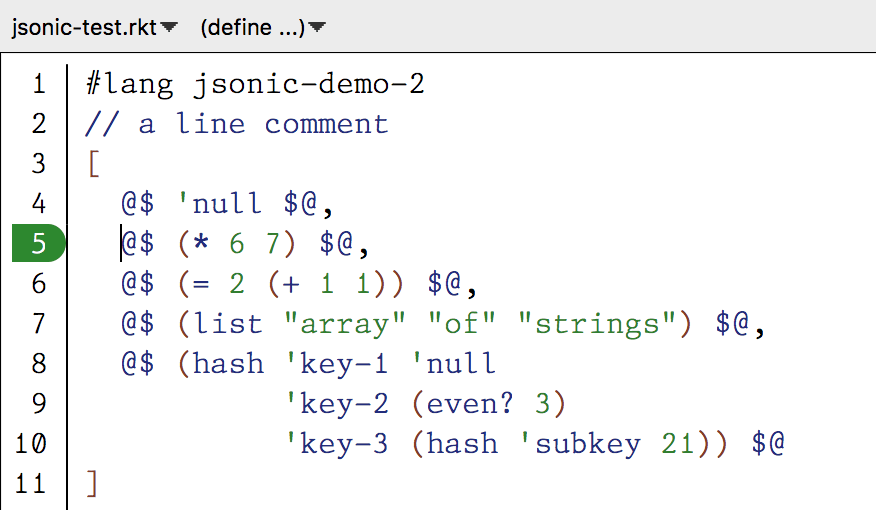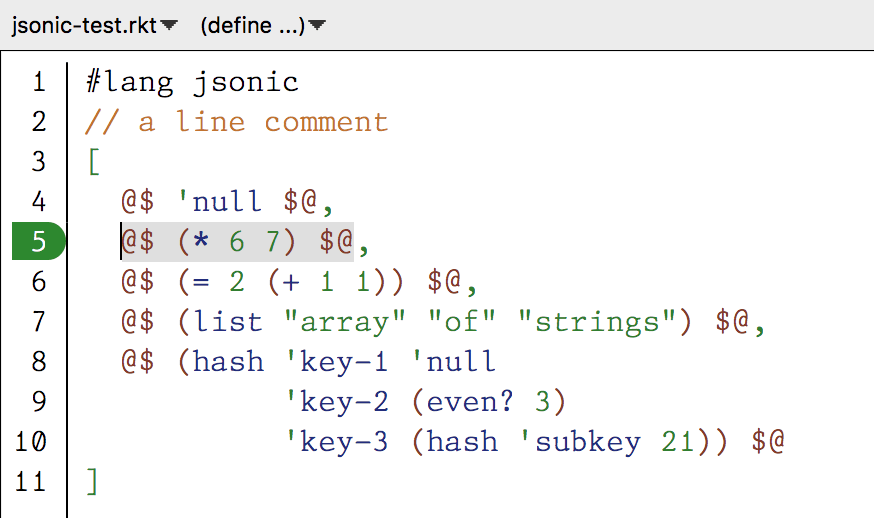Beautiful Racket / tutorials
- 1 intro
- 2 setup
- 3 contracts
- 4 unit tests
- 5 source locations
- 6 drracket integration
- 7 syntax coloring
- 8 indenting
- 9 toolbar buttons
- 10 recap
- 11 source listing
jsonic/colorer.rkt
#lang br
(require brag/support syntax-color/racket-lexer)
(define jsonic-lexer
(lexer
···))
(define (color-jsonic port offset racket-coloring-mode?) ···)
(provide color-jsonic)
(require brag/support syntax-color/racket-lexer)
(define jsonic-lexer
(lexer
···))
(define (color-jsonic port offset racket-coloring-mode?) ···)
(provide color-jsonic)
jsonic/colorer.rkt
#lang br
(require brag/support syntax-color/racket-lexer)
(define jsonic-lexer
(lexer
[(eof) (values lexeme 'eof #f #f #f)]))
(define (color-jsonic port offset racket-coloring-mode?) ···)
(provide color-jsonic)
(require brag/support syntax-color/racket-lexer)
(define jsonic-lexer
(lexer
[(eof) (values lexeme 'eof #f #f #f)]))
(define (color-jsonic port offset racket-coloring-mode?) ···)
(provide color-jsonic)
jsonic/colorer.rkt
#lang br
(require brag/support syntax-color/racket-lexer)
(define jsonic-lexer
(lexer
[(eof) (values lexeme 'eof #f #f #f)]
[(:or "@$" "$@")
(values lexeme 'parenthesis
(if (equal? lexeme "@$") '|(| '|)|)
(pos lexeme-start) (pos lexeme-end))]))
(define (color-jsonic port offset racket-coloring-mode?) ···)
(provide color-jsonic)
(require brag/support syntax-color/racket-lexer)
(define jsonic-lexer
(lexer
[(eof) (values lexeme 'eof #f #f #f)]
[(:or "@$" "$@")
(values lexeme 'parenthesis
(if (equal? lexeme "@$") '|(| '|)|)
(pos lexeme-start) (pos lexeme-end))]))
(define (color-jsonic port offset racket-coloring-mode?) ···)
(provide color-jsonic)
1 2 3 4 5 6 7 8 9 10 11 12 13 14 | #lang br (require brag/support syntax-color/racket-lexer) (define jsonic-lexer (lexer [(eof) (values lexeme 'eof #f #f #f)] [(:or "@$" "$@") (values lexeme 'parenthesis (if (equal? lexeme "@$") '|(| '|)|) (pos lexeme-start) (pos lexeme-end))])) (define (color-jsonic port offset racket-coloring-mode?) ···) (provide color-jsonic) |
jsonic/colorer.rkt
#lang br
(require brag/support syntax-color/racket-lexer)
(define jsonic-lexer
(lexer
[(eof) (values lexeme 'eof #f #f #f)]
[(:or "@$" "$@")
(values lexeme 'parenthesis
(if (equal? lexeme "@$") '|(| '|)|)
(pos lexeme-start) (pos lexeme-end))]
[(from/to "//" "\n")
(values lexeme 'comment #f
(pos lexeme-start) (pos lexeme-end))]
[any-char
(values lexeme 'string #f
(pos lexeme-start) (pos lexeme-end))]))
(define (color-jsonic port offset racket-coloring-mode?) ···)
(provide color-jsonic)
(require brag/support syntax-color/racket-lexer)
(define jsonic-lexer
(lexer
[(eof) (values lexeme 'eof #f #f #f)]
[(:or "@$" "$@")
(values lexeme 'parenthesis
(if (equal? lexeme "@$") '|(| '|)|)
(pos lexeme-start) (pos lexeme-end))]
[(from/to "//" "\n")
(values lexeme 'comment #f
(pos lexeme-start) (pos lexeme-end))]
[any-char
(values lexeme 'string #f
(pos lexeme-start) (pos lexeme-end))]))
(define (color-jsonic port offset racket-coloring-mode?) ···)
(provide color-jsonic)
1 2 3 4 5 6 7 8 9 10 11 12 13 14 15 16 17 18 19 20 | #lang br (require brag/support syntax-color/racket-lexer) (define jsonic-lexer (lexer [(eof) (values lexeme 'eof #f #f #f)] [(:or "@$" "$@") (values lexeme 'parenthesis (if (equal? lexeme "@$") '|(| '|)|) (pos lexeme-start) (pos lexeme-end))] [(from/to "//" "\n") (values lexeme 'comment #f (pos lexeme-start) (pos lexeme-end))] [any-char (values lexeme 'string #f (pos lexeme-start) (pos lexeme-end))])) (define (color-jsonic port offset racket-coloring-mode?) ···) (provide color-jsonic) |
jsonic/colorer.rkt
#lang br
(require brag/support syntax-color/racket-lexer)
(define jsonic-lexer ···)
(define (color-jsonic port offset racket-coloring-mode?)
(cond
[(or (not racket-coloring-mode?)
(equal? (peek-string 2 0 port) "$@"))
(define-values (str cat paren start end)
(jsonic-lexer port))
(define switch-to-racket-mode (equal? str "@$"))
(values str cat paren start end 0 switch-to-racket-mode)]
[else
···]))
(provide color-jsonic)
(require brag/support syntax-color/racket-lexer)
(define jsonic-lexer ···)
(define (color-jsonic port offset racket-coloring-mode?)
(cond
[(or (not racket-coloring-mode?)
(equal? (peek-string 2 0 port) "$@"))
(define-values (str cat paren start end)
(jsonic-lexer port))
(define switch-to-racket-mode (equal? str "@$"))
(values str cat paren start end 0 switch-to-racket-mode)]
[else
···]))
(provide color-jsonic)
1 2 3 4 5 6 7 8 9 10 11 12 13 14 15 16 17 | #lang br (require brag/support syntax-color/racket-lexer) (define jsonic-lexer ···) (define (color-jsonic port offset racket-coloring-mode?) (cond [(or (not racket-coloring-mode?) (equal? (peek-string 2 0 port) "$@")) (define-values (str cat paren start end) (jsonic-lexer port)) (define switch-to-racket-mode (equal? str "@$")) (values str cat paren start end 0 switch-to-racket-mode)] [else ···])) (provide color-jsonic) |
jsonic/colorer.rkt
#lang br
(require brag/support syntax-color/racket-lexer)
(define jsonic-lexer ···)
(define (color-jsonic port offset racket-coloring-mode?)
(cond
[(or (not racket-coloring-mode?)
(equal? (peek-string 2 0 port) "$@"))
(define-values (str cat paren start end)
(jsonic-lexer port))
(define switch-to-racket-mode (equal? str "@$"))
(values str cat paren start end 0 switch-to-racket-mode)]
[else
(define-values (str cat paren start end)
(racket-lexer port))
(values str cat paren start end 0 #t)]))
(provide color-jsonic)
(require brag/support syntax-color/racket-lexer)
(define jsonic-lexer ···)
(define (color-jsonic port offset racket-coloring-mode?)
(cond
[(or (not racket-coloring-mode?)
(equal? (peek-string 2 0 port) "$@"))
(define-values (str cat paren start end)
(jsonic-lexer port))
(define switch-to-racket-mode (equal? str "@$"))
(values str cat paren start end 0 switch-to-racket-mode)]
[else
(define-values (str cat paren start end)
(racket-lexer port))
(values str cat paren start end 0 #t)]))
(provide color-jsonic)
1 2 3 4 5 6 7 8 9 10 11 12 13 14 15 16 17 18 19 | #lang br (require brag/support syntax-color/racket-lexer) (define jsonic-lexer ···) (define (color-jsonic port offset racket-coloring-mode?) (cond [(or (not racket-coloring-mode?) (equal? (peek-string 2 0 port) "$@")) (define-values (str cat paren start end) (jsonic-lexer port)) (define switch-to-racket-mode (equal? str "@$")) (values str cat paren start end 0 switch-to-racket-mode)] [else (define-values (str cat paren start end) (racket-lexer port)) (values str cat paren start end 0 #t)])) (provide color-jsonic) |
jsonic/main.rkt
#lang br/quicklang
(module reader br
(require "reader.rkt")
(provide read-syntax get-info)
(define (get-info port src-mod src-line src-col src-pos)
(define (handle-query key default)
(case key
[(color-lexer)
(dynamic-require 'jsonic/colorer 'color-jsonic)]
#;[(drracket:indentation)
(dynamic-require 'jsonic/indenter 'indent-jsonic)]
#;[(drracket:toolbar-buttons)
(dynamic-require 'jsonic/buttons 'button-list)]
[else default]))
handle-query))
(module reader br
(require "reader.rkt")
(provide read-syntax get-info)
(define (get-info port src-mod src-line src-col src-pos)
(define (handle-query key default)
(case key
[(color-lexer)
(dynamic-require 'jsonic/colorer 'color-jsonic)]
#;[(drracket:indentation)
(dynamic-require 'jsonic/indenter 'indent-jsonic)]
#;[(drracket:toolbar-buttons)
(dynamic-require 'jsonic/buttons 'button-list)]
[else default]))
handle-query))
1 2 3 4 5 6 7 8 9 10 11 12 13 14 15 | #lang br/quicklang (module reader br (require "reader.rkt") (provide read-syntax get-info) (define (get-info port src-mod src-line src-col src-pos) (define (handle-query key default) (case key [(color-lexer) (dynamic-require 'jsonic/colorer 'color-jsonic)] #;[(drracket:indentation) (dynamic-require 'jsonic/indenter 'indent-jsonic)] #;[(drracket:toolbar-buttons) (dynamic-require 'jsonic/buttons 'button-list)] [else default])) handle-query)) |
jsonic/colorer.rkt
#lang br
(require brag/support syntax-color/racket-lexer
racket/contract)
(define jsonic-lexer
(lexer
[(eof) (values lexeme 'eof #f #f #f)]
[(:or "@$" "$@")
(values lexeme 'parenthesis
(if (equal? lexeme "@$") '|(| '|)|)
(pos lexeme-start) (pos lexeme-end))]
[(from/to "//" "\n")
(values lexeme 'comment #f
(pos lexeme-start) (pos lexeme-end))]
[any-char
(values lexeme 'string #f
(pos lexeme-start) (pos lexeme-end))]))
(define (color-jsonic port offset racket-coloring-mode?)
(cond
[(or (not racket-coloring-mode?)
(equal? (peek-string 2 0 port) "$@"))
(define-values (str cat paren start end)
(jsonic-lexer port))
(define switch-to-racket-mode (equal? str "@$"))
(values str cat paren start end 0 switch-to-racket-mode)]
[else
(define-values (str cat paren start end)
(racket-lexer port))
(values str cat paren start end 0 #t)]))
(provide
(contract-out
[color-jsonic
(input-port? exact-nonnegative-integer? boolean?
. -> . (values
(or/c string? eof-object?)
symbol?
(or/c symbol? #f)
(or/c exact-positive-integer? #f)
(or/c exact-positive-integer? #f)
exact-nonnegative-integer?
boolean?))]))
(require brag/support syntax-color/racket-lexer
racket/contract)
(define jsonic-lexer
(lexer
[(eof) (values lexeme 'eof #f #f #f)]
[(:or "@$" "$@")
(values lexeme 'parenthesis
(if (equal? lexeme "@$") '|(| '|)|)
(pos lexeme-start) (pos lexeme-end))]
[(from/to "//" "\n")
(values lexeme 'comment #f
(pos lexeme-start) (pos lexeme-end))]
[any-char
(values lexeme 'string #f
(pos lexeme-start) (pos lexeme-end))]))
(define (color-jsonic port offset racket-coloring-mode?)
(cond
[(or (not racket-coloring-mode?)
(equal? (peek-string 2 0 port) "$@"))
(define-values (str cat paren start end)
(jsonic-lexer port))
(define switch-to-racket-mode (equal? str "@$"))
(values str cat paren start end 0 switch-to-racket-mode)]
[else
(define-values (str cat paren start end)
(racket-lexer port))
(values str cat paren start end 0 #t)]))
(provide
(contract-out
[color-jsonic
(input-port? exact-nonnegative-integer? boolean?
. -> . (values
(or/c string? eof-object?)
symbol?
(or/c symbol? #f)
(or/c exact-positive-integer? #f)
(or/c exact-positive-integer? #f)
exact-nonnegative-integer?
boolean?))]))
1 2 3 4 5 6 7 8 9 10 11 12 13 14 15 16 17 18 19 20 21 22 23 24 25 26 27 28 29 30 31 32 33 34 35 36 37 38 39 40 41 42 43 | #lang br (require brag/support syntax-color/racket-lexer racket/contract) (define jsonic-lexer (lexer [(eof) (values lexeme 'eof #f #f #f)] [(:or "@$" "$@") (values lexeme 'parenthesis (if (equal? lexeme "@$") '|(| '|)|) (pos lexeme-start) (pos lexeme-end))] [(from/to "//" "\n") (values lexeme 'comment #f (pos lexeme-start) (pos lexeme-end))] [any-char (values lexeme 'string #f (pos lexeme-start) (pos lexeme-end))])) (define (color-jsonic port offset racket-coloring-mode?) (cond [(or (not racket-coloring-mode?) (equal? (peek-string 2 0 port) "$@")) (define-values (str cat paren start end) (jsonic-lexer port)) (define switch-to-racket-mode (equal? str "@$")) (values str cat paren start end 0 switch-to-racket-mode)] [else (define-values (str cat paren start end) (racket-lexer port)) (values str cat paren start end 0 #t)])) (provide (contract-out [color-jsonic (input-port? exact-nonnegative-integer? boolean? . -> . (values (or/c string? eof-object?) symbol? (or/c symbol? #f) (or/c exact-positive-integer? #f) (or/c exact-positive-integer? #f) exact-nonnegative-integer? boolean?))])) |
jsonic/colorer.rkt
#lang br
(require brag/support syntax-color/racket-lexer
racket/contract)
(define jsonic-lexer
(lexer
[(eof) (values lexeme 'eof #f #f #f)]
[(:or "@$" "$@")
(values lexeme 'parenthesis
(if (equal? lexeme "@$") '|(| '|)|)
(pos lexeme-start) (pos lexeme-end))]
[(from/to "//" "\n")
(values lexeme 'comment #f
(pos lexeme-start) (pos lexeme-end))]
[any-char
(values lexeme 'string #f
(pos lexeme-start) (pos lexeme-end))]))
(define (color-jsonic port offset racket-coloring-mode?)
(cond
[(or (not racket-coloring-mode?)
(equal? (peek-string 2 0 port) "$@"))
(define-values (str cat paren start end)
(jsonic-lexer port))
(define switch-to-racket-mode (equal? str "@$"))
(values str cat paren start end 0 switch-to-racket-mode)]
[else
(define-values (str cat paren start end)
(racket-lexer port))
(values str cat paren start end 0 #t)]))
(provide
(contract-out
[color-jsonic
(input-port? exact-nonnegative-integer? boolean?
. -> . (values
(or/c string? eof-object?)
symbol?
(or/c symbol? #f)
(or/c exact-positive-integer? #f)
(or/c exact-positive-integer? #f)
exact-nonnegative-integer?
boolean?))]))
(module+ test
(require rackunit)
(check-equal? (values->list
(color-jsonic (open-input-string "x") 0 #f))
(list "x" 'string #f 1 2 0 #f)))
(require brag/support syntax-color/racket-lexer
racket/contract)
(define jsonic-lexer
(lexer
[(eof) (values lexeme 'eof #f #f #f)]
[(:or "@$" "$@")
(values lexeme 'parenthesis
(if (equal? lexeme "@$") '|(| '|)|)
(pos lexeme-start) (pos lexeme-end))]
[(from/to "//" "\n")
(values lexeme 'comment #f
(pos lexeme-start) (pos lexeme-end))]
[any-char
(values lexeme 'string #f
(pos lexeme-start) (pos lexeme-end))]))
(define (color-jsonic port offset racket-coloring-mode?)
(cond
[(or (not racket-coloring-mode?)
(equal? (peek-string 2 0 port) "$@"))
(define-values (str cat paren start end)
(jsonic-lexer port))
(define switch-to-racket-mode (equal? str "@$"))
(values str cat paren start end 0 switch-to-racket-mode)]
[else
(define-values (str cat paren start end)
(racket-lexer port))
(values str cat paren start end 0 #t)]))
(provide
(contract-out
[color-jsonic
(input-port? exact-nonnegative-integer? boolean?
. -> . (values
(or/c string? eof-object?)
symbol?
(or/c symbol? #f)
(or/c exact-positive-integer? #f)
(or/c exact-positive-integer? #f)
exact-nonnegative-integer?
boolean?))]))
(module+ test
(require rackunit)
(check-equal? (values->list
(color-jsonic (open-input-string "x") 0 #f))
(list "x" 'string #f 1 2 0 #f)))
1 2 3 4 5 6 7 8 9 10 11 12 13 14 15 16 17 18 19 20 21 22 23 24 25 26 27 28 29 30 31 32 33 34 35 36 37 38 39 40 41 42 43 44 45 46 47 48 49 | #lang br (require brag/support syntax-color/racket-lexer racket/contract) (define jsonic-lexer (lexer [(eof) (values lexeme 'eof #f #f #f)] [(:or "@$" "$@") (values lexeme 'parenthesis (if (equal? lexeme "@$") '|(| '|)|) (pos lexeme-start) (pos lexeme-end))] [(from/to "//" "\n") (values lexeme 'comment #f (pos lexeme-start) (pos lexeme-end))] [any-char (values lexeme 'string #f (pos lexeme-start) (pos lexeme-end))])) (define (color-jsonic port offset racket-coloring-mode?) (cond [(or (not racket-coloring-mode?) (equal? (peek-string 2 0 port) "$@")) (define-values (str cat paren start end) (jsonic-lexer port)) (define switch-to-racket-mode (equal? str "@$")) (values str cat paren start end 0 switch-to-racket-mode)] [else (define-values (str cat paren start end) (racket-lexer port)) (values str cat paren start end 0 #t)])) (provide (contract-out [color-jsonic (input-port? exact-nonnegative-integer? boolean? . -> . (values (or/c string? eof-object?) symbol? (or/c symbol? #f) (or/c exact-positive-integer? #f) (or/c exact-positive-integer? #f) exact-nonnegative-integer? boolean?))])) (module+ test (require rackunit) (check-equal? (values->list (color-jsonic (open-input-string "x") 0 #f)) (list "x" 'string #f 1 2 0 #f))) |






